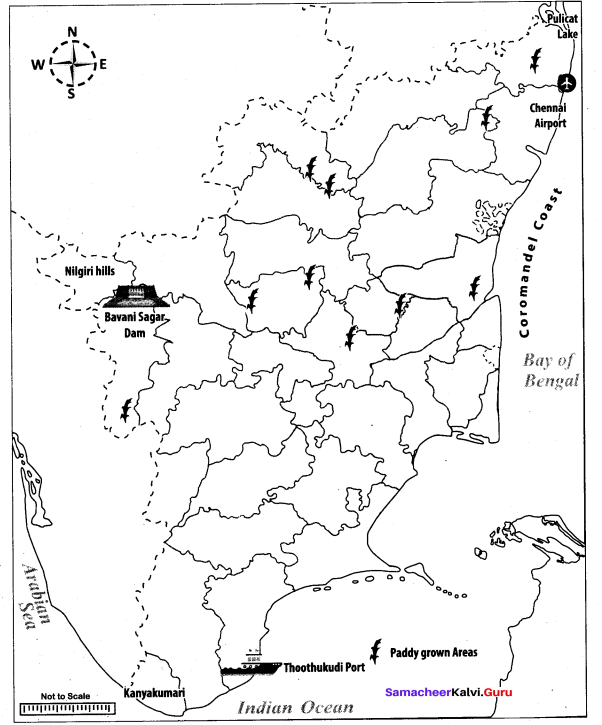Students can Download Samacheer Kalvi 10th Social Science Model Question Paper 5 English Medium Pdf, Samacheer Kalvi 10th Social Science Model Question Papers helps you to revise the complete Tamilnadu State Board New Syllabus and score more marks in your examinations.
Tamil Nadu Samacheer Kalvi 10th Social Science Model Question Paper 5 English Medium
General Instructions:
- The question paper comprises of four parts
- You are to attempt all the questions in each part. An internal choice of questions is provided wherever applicable.
- All questions of Part I, II, III and IV are to be attempted separately.
- Question numbers 1 to 14 in Part I are Multiple Choice Questions of one mark each.
These are to be answered by writing the correct answer along with the corresponding option code and the corresponding answer - Question numbers 15 to 28 in Part II are of two marks each. Any one question should be answered compulsorily.
- Question numbers 29 to 42 in Part III are of five marks each. Any one question should be answered compulsorily.
- Question numbers 43 to 44 in Part IV are of Eight marks each. Draw diagrams wherever necessary.
Time: 3 Hours
Maximum Marks: 100
Part – I
Answer all the questions. Choose the correct answer [14 × 1 = 14]
Question 1.
With whom of the following was Lateran Treaty signed by Italy?
(a) Germany
(b) Russia
(c) Pope
(d) Spain
Answer:
(c) Pope
Question 2.
Where was the third session of the Indian National Congress held?
(a) Marina
(b) Mylapore
(c) Fort St.Gerorge
(d) Thousand Lights
Answer:
(d) Thousand Lights
Question 3.
Who was the first Indian Judge of the Madras High Court?
(a) T. Muthuswamy
(b) P.S. Sivasamy
(c) V.S. Srinivasa Sastri
(d) G.A. Natesan
Answer:
(a) T. Muthuswamy
![]()
Question 4.
India’s first organised trade union, the Madras Labour Union was formed in
(a) 1918
(b) 1917
(c) 1916
(d) 1914
Answer:
(a) 1918
Question 5.
Assertion (A): The Revolt of 1857 was brutally suppressed by the British army.
Reason (R): The failure of the rebellion was due to the absence of Central authority.
(a) Both (A) and (R) are wrong
(b) (A) is wrong and (R) is correct
(c) Both (A) and (R) are correct and R is the correct explanation of A
(d) Both (A) and (R) are correct, but R is not the correct explanation of A
Answer:
(c) Both (A) and (R) are correct and R is the correct explanation of A
Question 6.
Pick the odd one out:
(a) Khadar
(b) Bhangar
(c) Alluvial soil
(d) Black soil
Answer:
(d) Black soil
Question 7.
A line joining the places of equal rainfall is
(a) Isohyet
(b) Isobar
(c) Isotherm
(d) Latitude
Answer:
(a) Isohyet
Question 8.
The first paper industry was started in
(a) Raniganj
(b) Durgapur
(c) Hoogly
(d) Baliganj
Answer:
(d) Baliganj
Question 9.
The scientific study of different aspects of population is called
(a) Photography
(b) Demography
(c) Choreography
(d) Population density
Answer:
(b) Demography
![]()
Question 10.
The latitudinal extent of Tamil Nadu is
(a) 8°5’N to 13°35’N
(b) 8°5’S to 13°35’S
(c) 8°0’N to 13°5’N
(d) 8°0’S to 13°05’S
Answer:
(a) 8°5’N to 13°35’N
Question 11.
Arrange the following in the correct chronological order and choose the correct answer from the code given below
(i) Panchsheel
(ii) Nuclear test at Pokhran
(iii) Twenty-year Treaty
(iv) First Nuclear test
(a) (i), (iii), (iv), (ii)
(b) (i), (ii), (iii), (iv)
(c) (i), (ii), (iv), (iii)
(d) (i), (iii), (ii), (iv)
Answer:
(a) (i), (iii), (iv), (ii)
Question 12.
The Chief Justice of Supreme Court can hold the office up to the age of (in year).
(a) 58
(b) 60
(c) 62
(d) 65
Answer:
(d) 65
Question 13.
Choose the incorrect statement(s):
(i) Shortage of goods, whether natural or artificial, is the root cause of black money.
(ii) industrial sector has been the major contributor to black money.
(iii) Smuggling is one of the major source of black money.
(iv) When the tax rate is low, more black money is generated.
(a) (i) and (ii)
(b) (iv)
(c) (i)
(d) (ii) and (iii)
Answer:
(b) (iv)
Question 14.
Basic Component(s) of food and nutrition security is / are
(a) availability
(b) access
(c) absorption
(d) all
Answer:
(d) all
Part – II
Answer any 10 questions. Question No. 28 is compulsory. [10 × 2 = 20]
Question 15.
Explain the Monroe Doctrine.
Answer:
- The famous Monroe doctrine was brought by Monroe, the president Of the USA.
- This doctrine declared that if Europeans interfered anywhere in America, north or south, it would amount to waging a war against the United States.
- This threat frightened the European powers and kept them away from South America.
Question 16.
What was Marshall plan?
Answer:
- The Marshall plan was an American initiative passed in 1948 to Western Europe, in which the United States gave over $ 12 Billion in economic assistance to help rebuild Western European economics after the end of World War II.
- It operated for four years beginning in April, 1948.
- The goal of the United States were to rebuild war tom regions, modernise industry and improve European prosperity.
Question 17.
Write the objectives of Home Rule Movement.
Answer:
- To attain self-government within British Empire by using constitutional means.
- To obtain the status of dominion, a political position accorded later to Australia, Canada, South Africa and New Zealand.
- To use non-violent constitutional methods to achieve their goals.
Question 18.
Name the Sangam texts for which Maraimalai Adigal wrote commentaries.
Answer:
Pattinappalai and Mullaipattu
Question 19.
Name the neighbouring countries of India.
Answer:
- India is a vast country with Pakistan and Afghanistan to the north-west
- China, Nepal, Bhutan to the north
- Bangladesh to the east Our
- Myanmar to the far east
- Sri Lanka (from south-east) and Maldives (from south-west) are two countries that lie close to India separated by the Indian Ocean.
Question 20.
State the types of agriculture practices in India.
Answer:
- Subsistence fanning
- Shifting Agriculture
- Intensive farming
- Dry farming
- Mixed farming agriculture
- Terrace cultivation
![]()
Question 21.
Define “International trade”.
Answer:
When trade takes place between two countries it is known as International trade.
Question 22.
Write a short note on Mangrove forest in Tamil Nadu.
Answer:
- The mangrove tidal forests are found in the areas of coasts influenced by tides. Hence,
mangroves are the common varieties with root of the plants submerged under water. - The delta of Cauvery are covered by such vegetation. Pichavaram is the important notable example of mangrove forests.
Question 23.
What is Money Bill?
Answer:
Money Bill refers to a bill (draft law) introduced in the Lok Sabha which generally covers the issue of receipt and spreading of money such as taxes, laws, prevention of black money etc.
Question 24.
Mention the names of the member countries of BRICS.
Answer:
Brazil, Russia, India, China and South Africa.
Question 25.
What is Per Capita Income?
Answer:
Per’ Capita Income or PCI is an indicator to show the living standard of people in a country. It is obtained by dividing the National Income by the population of a country.
Question 26.
Define: Food Security according to FAO.
Answer:
According to FAO (2009), “food security exists when all people, at all times, have physical, social and economic access to sufficient, safe and nutritious food which meets their dietary needs and food preference for an active and healthy life”.
Question 27.
Define: Tax.
Answer:
Tax is a compulsory contribution from a person to the government to defray the expenses incurred in the common interest of all without reference to special benefits conferred.
![]()
Question 28.
What do you know about Renewable resources?
Answer:
- It can be renewed in a short period of time.
- The time taken to renew the resources may be different from one resource to another.
Example: Solar, wind, water, forest and wild life.
Part – III
Answer any 10 questions. Question No. 42 is compulsory. [10 × 5 = 50]
Question 29.
Fill in the blanks
(i) ……………………… was the Headquarters of the Council of Europe.
(ii) ……………………… Soil is suitable for the cultivation of tea and coffee plants.
(iii) ……………………… is the first women Governor of Tamil Nadu.
(iv) The term globalization invented by………………………
(v) ……………………… is the highest peak of South India.
Answers :
(i) Strasbourg
(ii) Laterite
(iii) M. Fathima Beevi
(iv) Prof. Theodore Levitt
(v) Anaimudi
Question 30.
Match the following

Answers:
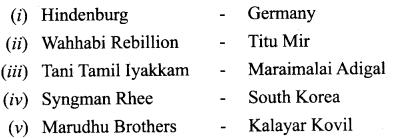
Question 31.
Match the following
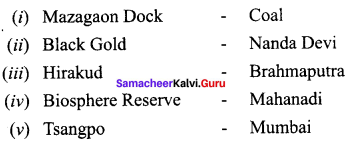
Answers:
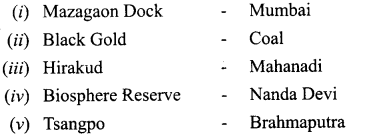
Question 32.
(a) Distinguish between:
(i) Weather and Climate
(ii) Agro based industries and Mineral based industries
Answer:
(a) (i) Weather and Climate
Weather :
- Weather is a day to day condition of the atmosphere of any place in regard to temperature, pressure, wind, humidity and rainfall.
- It is calculated for a day or a short period of time.
Climate :
- Climate is the average state of weather for a longer period of time at any place.
- To get reliable average of climate a minimum of 35 year records of weather are necessary.
(ii) Agro based Industries and Mineral based Industries
Agro Rased Industries :
- Agro based industries use agricultural products as their raw materials.
- The major agro based industries of our country are cotton textile industry, jute industry, sugar industry etc.
- These industries are located near the areas of cultivation.
Mineral Based Industries
- Mineral based industries use both metallic and non metallic minerals as their raw materials.
- The major minerals based industry of our country is the iron and steel industry.
- These industries are located either near the coal field or iron ore mines.
(b) Give Reason: Rain water harvesting is necessary.
Answer:
- India experiences tropical monsoon type of climate. It gives a seasonal rainfall. .
- Most of the time the rainfall is scanty hence it is necessary to save available rain water. We must allow the water to penetrate in the deep water table and tap this water when it is necessary.
- In order to prevent surface run-off we must harvest the rain water for further domestic related and other activities.
Question 33.
Assess the structure and activities of the UN.
Answer:
- The United Nations came into existence in the year 1945 to achieve lasting peace among all nation which were inter dependent. It functions like any government, through its principal organs which are similar to the legislative, executive and judicial wings of a state.
- The General Assembly is the body in which each member state is represented. It meets once a year and issues of interest and points of conflict are discussed in the Assembly.
- The Security Council has fifteen members, five of them (the USA, Britain, France, Russia and China) are permanent members. The other ten temporary members are elected in rotation from different parts of the world. Each of the permanent member has the right to vote any decision by the other members of the Security Council.
- The UN Secretariat is headed by the Secretary General, who is elected by the General Assembly on the recommendation of the Security Council.
- The International Court of Justice is the judicial wing of the United Nations. Its headquarters is at the Hague.
- The fifth organ of the UN is the Economic and Social Council (ECOSOC). It is responsible for coordinating ail the economic and social work of the United Nations.
Activities of the United Nations:
Human rights, the problems of refugees, climate change, gender equality are all within the ambit of the activities of the United Nations. The UN Peace Keeping Force has acted in many areas of conflict all over the world.
Question 34.
What do you know about ‘Salt March to Vedaranyam’?
Answer:
(i) The Viceroy did not accept the demands put forward by Gandhi, he launched the civil Disobedience Movement by setting out on a Salt Satyagraha with a march to Dandi on 12,h March, 1930.
(ii) Tamil Nadu was in the forefront of the Civil Disobedience Movement. In the city of Madras, shops were picketed and foreign goods boycotted. Rajaji organised and led a Salt Satyagraha march to Vedaranyam. The march started from Tiruchirappalli on 13 April, 1930 and reached Vedaranyam in Thanjavur district on April 28th. On reaching Vedaranyam 12 volunteers under the leadership of Rajaji broke the salt law by picking up salt. Rajaji was arrested.
Question 35.
Write about southwest monsoon.
Answer:
- The southwest monsoon is the most significant feature of the Indian climate.
- The onset of the southwest monsoon takes place normally over the southern tip of the country by the first week of June, advances along the Konkan coast in early June and covers the whole country by 15th July.
- The monsoon is influenced by global phenomenon like El Nino.
- Prior to the onset of the southwest monsoon, the temperature in the north India reaches upto 46° C.
- The sudden approach of monsoon wind over South India with lightning and thunder is termed as ‘break’ or ‘burst of monsoon’.
- It lowers the temperature of India to a large extent.
- The monsoon wind strikes against the southern tip of Indian land mass and gets divided into two branches.
- One branch starts from Arabian sea and the other from Bay of Bengal.
- The Arabian sea branch of southwest monsoon gives heavy rainfall to the west coast of
India as it is located in windward side of the Western Ghats. - The other part which advances towards north is obstructed by Himalayan Mountain and results in heavy rainfall in north.
- As Aravalli mountain is located parallel to the wind direction, Rajasthan and Western part do not get much rainfall from this branch.
- The wind from Bay of Bengal branch moves towards northeast India and Myanmar.
- This wind is trapped by a chain of mountains namely, Garo, Khasi and Jaintia are mainly responsible for the heaviest rainfall caused at Mawsynram located in Meghalaya.
- Later on, this wind travel towards west which results in decrease in rainfall from east to west.
- Over all about 75% of Indian rainfall is received from this monsoon.
- Tamil Nadu which is located in the leeward side receives only a meagre rainfall.
Question 36.
Give an account of water resources of Tamil Nadu.
Answer:
Surface Water Resources:
- The total surface water potential of the state is about 24,864 mcm. There are 17 major river basin in the state with 81 reservoirs and about 41,262 tanks.
- Most of the surface water has already been tapped primarily for irrigation, where water use is largest.
- An area of 24 lakh hectares of the land are irrigated by surface water through major, medium and minor schemes.
Ground Water Resources:
- The utilizable ground water resources of the state is 22,423 mcm.
- The current level of utilization of water is about 13,558 mcm which is about 60% of the available recharge, while about 8875 mcm is the balance available for use.
Water Resource Management:
- Water Resource Management is the activity of planning, developing, distributing and managing the optimum use of water resources.
- The demand for water in TN is, increasing at a fast rate both due to increasing population and also due to larger per capita needs triggered by economic growth. ’
- Agriculture is the largest consumer of water in the state using 75% of the state’s water resources.
- The state is heavily dependent on monsoon rain since the state is entirely dependent on rain for recharging its water resources, monsoon failure leads to acute water scarcity and severe droughts. So it is important to save water for us and the future generation.
![]()
Question 37.
Point out the Fundamental Rights.
Answer:
The Fundamental Rights are enshrined in Part III of the Constitution from Articles 12 to 35.
There are six Fundamental Rights.
- Right to Equality:- It provides equality before law. It prohibits discrimination on grounds of religion, race, caste, sex or place of birth. It abolishes untouchability.
- Right to Freedom:- It provides freedom of speech and expression, assembly, association, movement, residence and profession.
- Right against Exploitation: It prohibits trafficking in human beings and forced labour.
It also prohibits employment of children in factories etc. - Right to Religion:- It gives freedom of conscience and free profession practice and propagations of religion.
- Cultural and Educational Rights:- It gives protection of language, script and culture of minorities. It also gives minorities the right to establish and administer educational institutions.
- Right to Constitutional Remedies:- It allows individual to seek redressal for the violations of their Fundamental Rights.
Question 38.
Explain about Panchsheel principles.
Answer:
- Mutual respect for each other’s territorial integrity and sovereignty.
- Mutual non-aggression.
- Mutual non-interference.
- Equality and co-operation for mutual benefit
- Peaceful co-existence.
Question 39.
What are the important characteristics of successful industrial clusters.
Answer:
- Geographical proximity of small and medium enterprises (SMEs)
- Sectoral specialisation
- Close inter-firm collaboration
- Inter firm competition based on innovation.
- A socio cultural identity which facilitates trust.
- Multi skilled work force.
- Active self-help organisation and
- Supportive regional and municipal governments.
Question 40.
What are the methods of calculating Gross Domestic Product? And explain.
Answer:
- Expenditure Approach: In this method, the GDP is measured by adding the expenditure on all the final goods and services produced in the country during a specified period.
- Income Approach:- This method looks at GDP from the perspective of the earnings of the men and women who are involved in producing the goods and services.
- Value-added Approach: In the value added approach the value added by each intermediate good is summed to estimate the value of the fiscal good. The sum of the value added by all the intermediate goods used in productions gives us the total value of the final goods produced in the country.
Question 41.
Draw a timeline for the following:
Write any five important events between 1920 -1940
Answer:
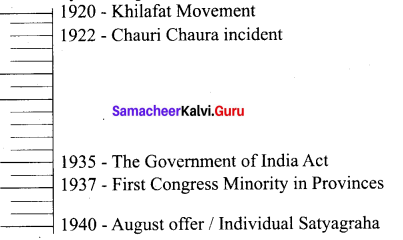
Question 42.
Mark the following places on the world map.
(i) Great Britain
(ii) Germany
(iii) Russia
(iv) Hiroshima
(v) Hawai Island
Answer:
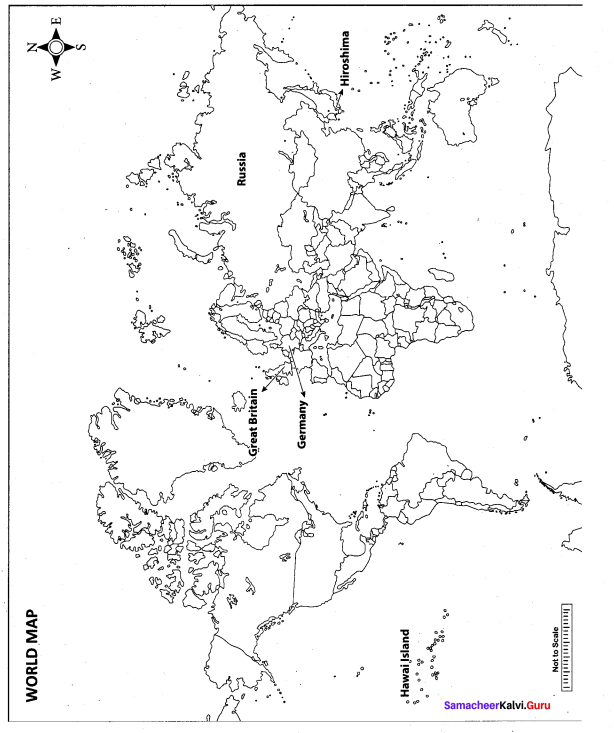
![]()
Part – IV
Answer both questions. [2 × 8 = 16]
Question 43.
(a) Balkan Wars
(i) Why was Balkan League Formed?
(ii) What was the outcome of the first Balkan War?
(iii) Who were defeated in this war?
(iv) What was the name of the Treaty signed at the end of this second Balkan War?
Answer:
(a) Balkan Wars:
(i) It was formed to attack and defeat Turkish forces in the first Balkan war in 1912-13.
(ii) The new state of Albanic was created and the other Balkan states divided up Macedonia between them. Turkey was reduced the area around Constantinople.
(iii) The Turkish Forces.
(iv) Treaty of Bucharest.
(b) Subash Chandra Bose and INA
(i) How did Subash Chandra Bose reach Japan?
(ii) Who headed the women wing of Indian National Army?
(iii) How did Subash Chandra Bose reorganize the INA?
(iv) Name the slogan provided by Subash Chandra Bose.
Answer:
(b) Subhas Chandra Bose and INA:
(i)He made his way to Japan on a submarine on February 1943.
(ii) Captain Lakshmi Sahgal
(iii) (1) Gandhi Brigade (2) Nehru Brigade (3) Rani of Jhansi Brigade
(iv) He gave the slogan‘Dilli Chalo’.
[OR]
Question 43.
(c) Ramalinga Adigal ‘
(i) What is Jeevakarunya?
(ii) What are the Songs of Grace?
(iii) Point out the major contribution of Samarasa Veda Sanmarga Sathya Sangam.
(iv) Where did he establish his free feeding house?
Answer:
(c) Ramalinga Adigal
(i) It is showing comparison and mercy on all living beings including plants.
(ii) His volumious songs that were compiled and published under the title Thiruvanrupta are called songs of Grace.
(iii) “Samarasa Vedha Sanmarga Sathya Sangam” means society for pure Truth in Universal selfhood.
(iv) He established a free feeding house for everyone irrespective of caste at Vadalur.
(d) Vellore Revolt:
(i) When did Vellore Revolt break out?
(ii) Who introduced new military regulation?
(iii) Who was the first victim of the revolt?
(iv) Who was proclaimed by the rebels as their new rules?
Answer:
(d) Vellore Revolt:
(i) 10th July 1806
(ii) Commander in Chief Sir John Cradock.
(iii) Colonel Fancourt
(iv) Fateh Hyder
Question 44.
Mark the following places on the given outline map of India.
(i) Aravalli range
(ii) River Cauvery .
(iii) Direction of South-West Monsoon winds
(iv) Agasthiyamalai bio-sphere reserve .
(v) The main region of black soil
(vi) Any one International Airport .
(vii) Atomic power station in Tamil Nadu
(viii) Railway route from Mumbai to Kolkata
Answer:
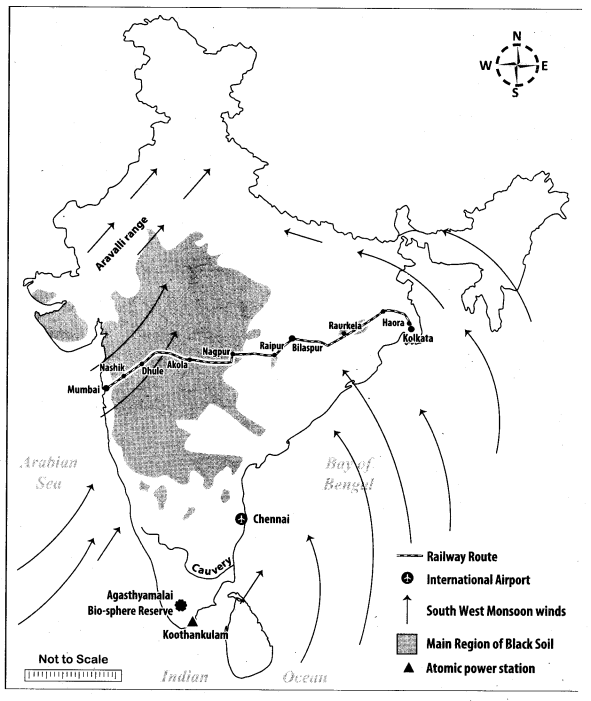
[OR]
Mark the following places on the given outline map of Tamil Nadu:
(i) Nilgiri hills
(ii) Coromandel Coast
(iii) A paddy growing area
(iv) Bavani Sagar Dam
(v) Thoothukudi Port
(vi) Any one International Airport
(vii) Pulicat lake
(viii) Kanyakumari
Answer:
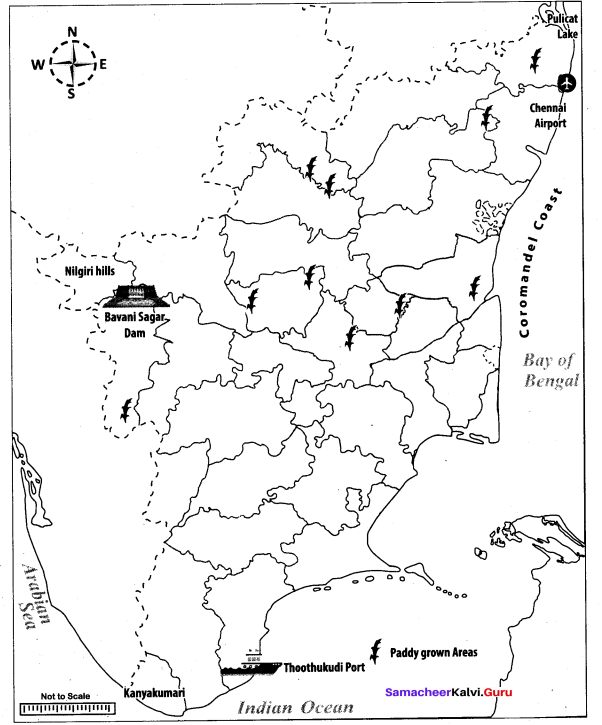
Map for Q. 42
(i) Great Britain
(ii) Germany
(iii) Russia
(iv) Hiroshima
(v) Hawai Island
Answer:
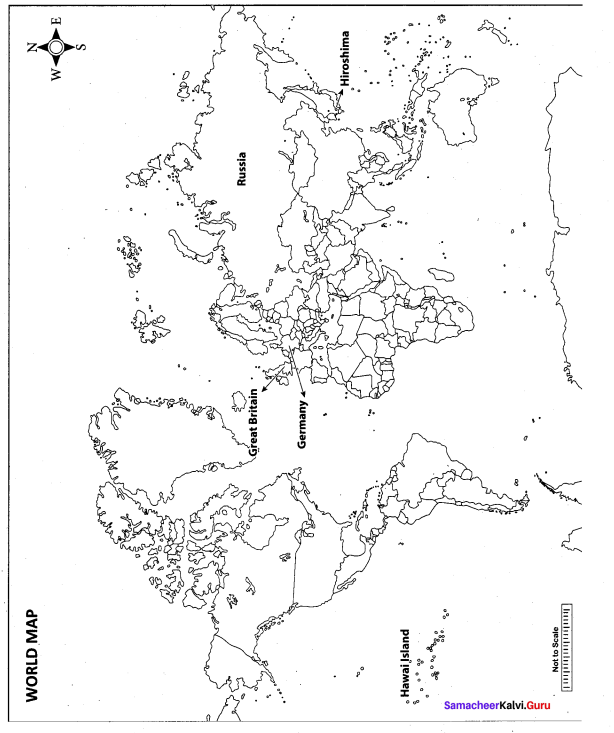
Map for Q. 44
(i) Aravalli range
(ii) River Cauvery
(iii) Direction of South-West Monsoon winds
(iv) Agasthiyamalai bio-sphere reserve
(v) The main region of black soil
(vi) Any one International Airport
(vii) Atomic power station in Tamil Nadu
(viii) Railway route from Mumbai to Kolkata
Answer:
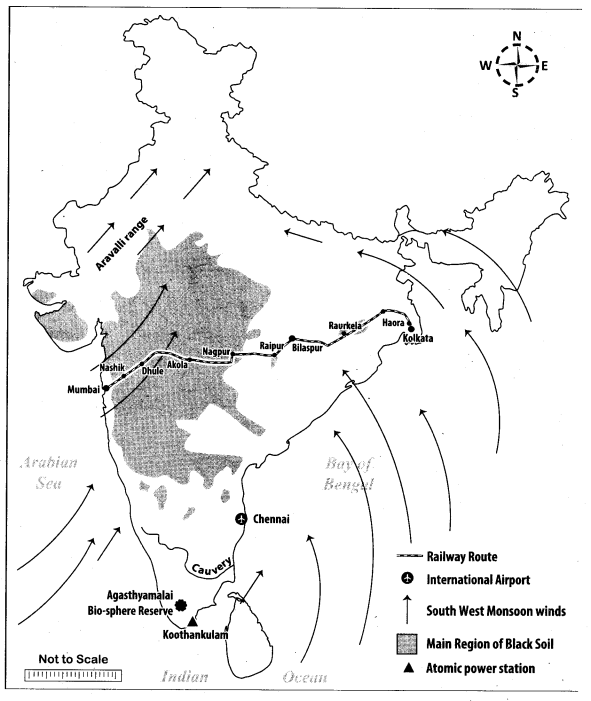
Map for Q. 44
(i) Nilgiri hills
(ii) Coromandel Coast
(iii) A paddy growing area
(iv) Bavani Sagar Dam
(v) Thoothukudi Port
(vi) Any one International Airport
(vii) Pulicatlake
(viii) Kanyakumari
Answer:
